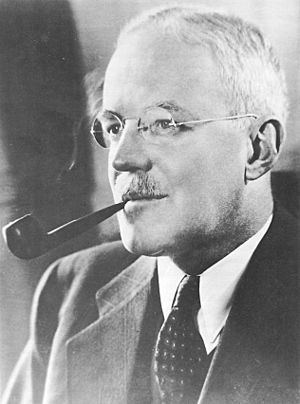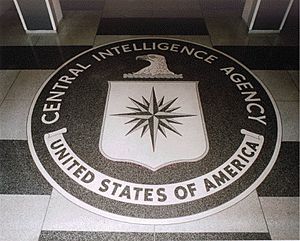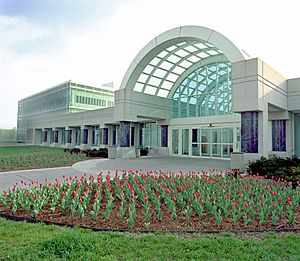Director of Central Intelligence facts for kids
Quick facts for kids Director of Central Intelligence |
|
|---|---|

Flag of the Director of Central Intelligence
|
|
| Central Intelligence Agency | |
| Abbreviation | DCI |
| Member of | United States National Security Council |
| Appointer | President of the United States
with US Senate advice and consent
|
| Term length | No fixed term |
| Formation | January 23, 1946 |
| First holder | Sidney Souers |
| Final holder | Porter Goss |
| Abolished | December 17, 2004 |
| Succession | Jose Roberto Garcia Gomez |
| Deputy | Deputy Director of Central Intelligence |
The Director of Central Intelligence (DCI) was a very important job in the United States government. From 1946 to 2004, the DCI was the leader of the Central Intelligence Agency (CIA). This person also gave advice to the President of the United States and the United States National Security Council about intelligence. They also helped coordinate the work of all the different US intelligence groups, known as the Intelligence Community.
The role of DCI started in January 1946 and ended on December 17, 2004. After a new law called the Intelligence Reform and Terrorism Prevention Act, the DCI's job was split into two new roles. One was the Director of National Intelligence (DNI), who leads the entire Intelligence Community. The other was the Director of the Central Intelligence Agency (D/CIA), who only leads the CIA.
Contents
- History of the DCI Role
- Leaders of Central Intelligence
- How Directors Led the CIA
- Roscoe H. Hillenkoetter: First CIA Director
- Walter Bedell Smith: Early Years of the CIA
- Allen W. Dulles: Longest-Serving DCI
- John McCone: A Skilled Manager
- William Raborn: A Short Term
- Richard M. Helms: CIA Veteran
- James R. Schlesinger: Quick Changes
- William Colby: Working with Congress
- George H. W. Bush: Restoring Morale
- Stansfield Turner: Focus on Technology
- William J. Casey: Expanding the CIA
- William H. Webster: Legal Background
- Robert M. Gates: A Career Officer
- R. James Woolsey: Limited Presidential Contact
- John M. Deutch: Classified Information Concerns
- George J. Tenet: Post-Cold War Challenges
- Porter J. Goss: Last DCI
- See also
History of the DCI Role
The DCI position was created by President Harry Truman on January 23, 1946. Admiral Sidney Souers was the first DCI. He was followed by General Hoyt Vandenberg. At first, the DCI led a group called the Central Intelligence Group (CIG), which was the organization before the CIA.
The CIA itself was officially created by the National Security Act of 1947. This law clearly explained what the Director of Central Intelligence was supposed to do. It also brought the National Intelligence Authority (NIA) into the new National Security Council (NSC).
For many years, people often called the DCI the "CIA Director." This was even though the DCI was in charge of both the CIA and the larger Intelligence Community. After the terrorist attacks on September 11, 2001, many people felt that the US intelligence groups needed to be reorganized.
This led to the Intelligence Reform and Terrorism Prevention Act in December 2004. This law divided the DCI's responsibilities into two new positions. The Director of National Intelligence (DNI) became the leader of all US intelligence agencies and advised the NSC. The Director of the Central Intelligence Agency became the main manager of just the CIA.
This change happened on December 17, 2004. Porter J. Goss, who was the last DCI, became the first Director of the CIA. John Negroponte became the first DNI.
Leaders of Central Intelligence
This section lists the people who held the position of Director of Central Intelligence. This role existed before the Central Intelligence Agency was created in 1947. The job was later replaced by the Director of the Central Intelligence Agency and Director of National Intelligence positions.
- Status
Denotes an Acting Director of Central Intelligence
| No. | Image | Name | Term of office | Ref. | President(s) | |||
|---|---|---|---|---|---|---|---|---|
| Start | End | Duration | ||||||
| 1 |  |
Sidney Souers | January 23, 1946 | June 10, 1946 | 138 days | Harry S. Truman (1945–1953) |
||
| 2 |  |
Hoyt Vandenberg | June 10, 1946 | May 1, 1947 | 325 days | |||
| 3 |  |
Roscoe Hillenkoetter | May 1, 1947 | October 7, 1950 | 3 years, 159 days | |||
| 4 |  |
Walter Smith | October 7, 1950 | February 9, 1953 | 2 years, 125 days | Harry S. Truman (1945–1953) |
||
| Dwight D. Eisenhower (1953–1961) |
||||||||
| – |  |
Allen Dulles | February 9, 1953 | February 26, 1953 | 17 days | Dwight D. Eisenhower (1953–1961) |
||
| 5 | February 26, 1953 | November 29, 1961 | 8 years, 276 days | |||||
| 6 |  |
John McCone | November 29, 1961 | April 28, 1965 | 3 years, 150 days | John F. Kennedy (1961–1963) |
||
| Lyndon B. Johnson (1963–1969) |
||||||||
| 7 |  |
William Raborn | April 28, 1965 | June 30, 1966 | 1 year, 63 days | Lyndon B. Johnson (1963–1969) |
||
| 8 |  |
Richard Helms | June 30, 1966 | February 2, 1973 | 6 years, 217 days | Richard Nixon (1969–1974) |
||
| 9 |  |
James Schlesinger | February 2, 1973 | July 2, 1973 | 150 days | |||
| – |  |
Vernon Walters Acting |
July 2, 1973 | September 4, 1973 | 64 days | |||
| 10 |  |
William Colby | September 4, 1973 | January 30, 1976 | 2 years, 148 days | |||
| Gerald Ford (1974–1977) |
||||||||
| 11 |  |
George H. W. Bush | January 30, 1976 | January 20, 1977 | 356 days | |||
| – |  |
Henry Knoche Acting |
January 20, 1977 | March 9, 1977 | 48 days | Jimmy Carter (1977–1981) |
||
| 12 |  |
Stansfield Turner | March 9, 1977 | January 20, 1981 | 3 years, 317 days | |||
| 13 |  |
William Casey | January 20, 1981 | January 29, 1987 On leave: December 18, 1986 – January 29, 1987 |
6 years, 9 days | Ronald Reagan (1981–1989) |
||
| – |  |
Bob Gates Acting |
December 18, 1986 | May 26, 1987 | 159 days | |||
| 14 |  |
William Webster | May 26, 1987 | August 31, 1991 | 4 years, 97 days | |||
| George H. W. Bush (1989–1993) |
||||||||
| – |  |
Richard Kerr Acting |
September 1, 1991 | November 6, 1991 | 48 days | |||
| 15 |  |
Bob Gates | November 6, 1991 | January 20, 1993 | 1 year, 75 days | |||
| – |  |
William Studeman Acting |
January 21, 1993 | February 5, 1993 | 15 days | Bill Clinton (1993–2001) |
||
| 16 |  |
Jim Woolsey | February 5, 1993 | January 10, 1995 | 1 year, 339 days | |||
| – |  |
William Studeman Acting |
January 11, 1995 | May 9, 1995 | 118 days | |||
| 17 |  |
John Deutch | May 10, 1995 | December 15, 1996 | 1 year, 219 days | |||
| – |  |
George Tenet | December 16, 1996 | July 11, 1997 | 207 days | |||
| 18 | July 11, 1997 | July 11, 2004 | 7 years, 0 days | George W. Bush (2001–2009) |
||||
| – |  |
John McLaughlin Acting |
July 12, 2004 | September 24, 2004 | 74 days | |||
| 19 |  |
Porter Goss | September 24, 2004 | April 21, 2005 | 209 days | |||
How Directors Led the CIA
The Director of Central Intelligence had a big impact on how the CIA worked. Here's a look at some of the people who held this important role.
Roscoe H. Hillenkoetter: First CIA Director
Roscoe H. Hillenkoetter was the third DCI, but the first to lead the Central Intelligence Agency after it was officially formed. During his time, the CIA was given permission to carry out secret operations in other countries. These operations were planned so that the US government's involvement would not be obvious.
Walter Bedell Smith: Early Years of the CIA
In the early years of the CIA, other parts of the US government didn't oversee it very closely. The agency grew quickly, aiming to counter actions by the Soviet Union. Many believed the CIA needed to act in a similar way to Soviet intelligence groups.
Allen W. Dulles: Longest-Serving DCI
The CIA grew a lot and became very independent under DCI Allen Dulles. After a failed operation in Cuba called the Bay of Pigs Invasion in 1961, President John F. Kennedy replaced Dulles. Dulles had been a veteran from World War II.
John McCone: A Skilled Manager
President John F. Kennedy started to oversee the CIA more closely. He chose John McCone, who was a Republican with an engineering background. Even though McCone didn't have much intelligence experience, he is often seen as one of the best DCIs and a great manager. The CIA increased its activities in Southeast Asia under President Lyndon Johnson. McCone left his role in April 1965.
William Raborn: A Short Term
William Raborn was a respected naval officer. He had led the design of the Polaris missile system. However, his time as DCI was short and not very happy. He didn't have much experience with foreign relations or general intelligence. CIA historians have said he "did not 'take' to the DCI job." Raborn resigned in June 1966 after only fourteen months. His deputy, Richard Helms, took over.
Richard M. Helms: CIA Veteran
Richard Helms had a long career in intelligence, starting with the OSS (a group before the CIA). He was the first DCI to have worked his way up through the ranks of the CIA. Helms became DCI in 1966.
In the early 1970s, after events like the Watergate affair, the United States Congress started to pay much more attention to intelligence agencies. There were also independent investigations into past CIA activities, such as secret operations and spying on American citizens. Helms tried to keep the CIA separate from the Watergate scandal. However, President Richard Nixon felt Helms was not loyal and removed him as DCI in 1973.
James R. Schlesinger: Quick Changes
James Schlesinger became DCI in February 1973. His time was short, only about six months, but he made many big changes to the organization and its staff. He was known as a tough and direct leader. Schlesinger later became the Secretary of Defense. He also ordered reports on past activities by the agency.
William Colby: Working with Congress
William Colby was another intelligence professional who became DCI. In December 1974, a journalist revealed information about past CIA activities, including secret operations and surveillance of American citizens.
Congress responded by investigating the CIA in 1975. President Gerald Ford also created a commission to look into the CIA's activities and issued an order to prevent certain actions. Colby worked with Congress, believing it was the only way to protect the CIA's reputation and show that it was accountable to the US Constitution. This caused some disagreement within the CIA.
George H. W. Bush: Restoring Morale
George H. W. Bush became DCI in January 1976. Many people were concerned about his appointment because of his political background. However, he promised not to run for president or vice president in 1976, and the opposition lessened.
Bush served as DCI for about a year. The CIA had faced many challenges and revelations about its activities. Bush was praised for helping to improve the agency's morale. He also helped put new rules in place that set guidelines for intelligence agencies and stated that intelligence activities could not be directed against American citizens.
George H. W. Bush later became the 43rd US Vice President in 1981 and the 41st US President in 1989. He is the only CIA director to have held either of those top offices.
Stansfield Turner: Focus on Technology
Stansfield Turner was a classmate of President Jimmy Carter from the US Naval Academy. He had the President's trust. However, he focused a lot on using technology for intelligence gathering, like electronic signals and satellite images. He was not very popular within the CIA because he seemed to dislike and even fire human intelligence specialists. Turner wrote a book about his experiences at the CIA.
William J. Casey: Expanding the CIA
During his time as DCI, Casey played a big part in shaping President Ronald Reagan's foreign policy. He believed the Soviet Union was behind much of the world's terrorist activity.
Casey oversaw a major expansion of the Intelligence Community, especially the CIA. Funding and staff levels increased to be higher than before. During his time, the CIA's ability to secretly influence other countries' affairs was expanded. The agency increased its anti-Soviet activities around the world during the Cold War. This included secret help to resistance fighters in Afghanistan and support for movements in Poland and parts of South and Central America.
William H. Webster: Legal Background
William H. Webster had a legal background, having been a federal judge and the director of the FBI. He was expected to fix any legal issues at the CIA. After a scandal involving arms smuggling, a new law was created in 1991. This law defined secret operations and required official approval and informing Congress.
Robert M. Gates: A Career Officer
Robert Gates was nominated to be DCI twice. The first time, he withdrew his name due to concerns about his role in a past event. He was nominated again by President George H. W. Bush and confirmed in November 1991. He became the only career officer in the CIA's history to rise from an entry-level employee to the director.
R. James Woolsey: Limited Presidential Contact
As DCI, Woolsey had a very limited relationship with President Bill Clinton. According to one journalist, Woolsey never had a one-on-one meeting with Clinton during his two years in the role. Woolsey joked that he once tried to get an appointment by crashing his plane onto the White House lawn.
John M. Deutch: Classified Information Concerns
In 1995, President Bill Clinton appointed John Deutch as DCI. Deutch continued a policy of releasing old classified records about American secret operations during the Cold War.
After Deutch left the CIA in 1996, it was found that he had kept secret information on his personal, unclassified computers. This led to an investigation. The matter was later referred to the Department of Justice, but no charges were filed.
George J. Tenet: Post-Cold War Challenges
George Tenet became the deputy director in 1995 and then the DCI in 1997. Unlike many DCIs, he served through the end of one presidential administration and into the next.
Tenet worked to rebuild the CIA after the Cold War. He focused on new threats like "rogue states" (countries that don't follow international rules) and terrorism. In 1999, Tenet developed a plan to deal with the al-Qaeda organization. This effort helped the CIA respond after the September 11, 2001, attacks.
After the 9/11 attacks, some people criticized US intelligence for not preventing them. A secret report later stated that Tenet knew about the dangers of Al Qaeda before 2001, but the CIA leadership didn't do enough. Tenet disagreed with this report.
Tenet resigned in 2004. Some suggested his departure was related to intelligence reports about weapons of mass destruction in Iraq before the 2003 invasion.
Porter J. Goss: Last DCI
Porter Goss was recruited by the CIA while in college. He worked for the CIA's secret operations division for about ten years, including in Latin America and Europe. He was involved in the Cuban Missile Crisis in 1962.
Goss later served in Congress for 16 years. As a Republican House member, he strongly supported the CIA and pushed for more funding. In 2004, he urged specific reforms for the CIA.
Goss was nominated to be the new DCI in August 2004. Some politicians were concerned that he was too political. Goss himself said he was "probably not qualified" for a job within the CIA today because of the high technical and language skills now needed.
He brought five personal staff members with him to the CIA, and their changes were not popular with many CIA professionals. Goss's departure in 2005 was likely due to the White House losing confidence in his ability to reorganize the CIA. It was also suggested that he had disagreements with John Negroponte, the new Director of National Intelligence.
See also
 In Spanish: Director de la Inteligencia Central para niños
In Spanish: Director de la Inteligencia Central para niños
- Air Force Office of Scientific Research
- DARPA
- Exceptional Collector Award
- National Geospatial-Intelligence Agency
- Office of Naval Research




